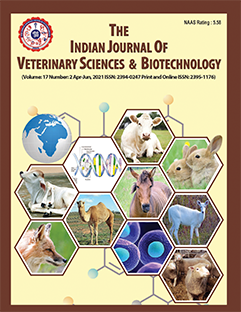Socio-Economic Dynamics and Management Practices Tailed for Palla Sheep of Andhra Pradesh: Insights into a Traditional Livelihood
DOI:
https://doi.org/10.48165/ijvsbt.21.4.20Keywords:
Breeding tract, Husbandry practices, Palla sheep, Socio-economic statusAbstract
The present study was carried out to explore the socio-economic status and husbandry practices followed by 88 shepherds rearing Palla sheep from 304 flocks of 38 mandals of four revenue divisions of Nellore district which is the sole breeding tract of Palla sheep in India. Most of the sheep flocks (95%) were reared by family members and majority of shepherds (79.93%) raised sheep using both stationary and migratory methods. The average migration distance of Palla flocks was 74.88 km. Majority of the farmers (92.04%) provided shelter at night and the nature of houses varied from part of residence (61.35%) to separate houses (38.65 %). The open and closed type of housing was followed in 59% and 40% of the flocks, respectively, and most of the sheep habitations were having thatched roofs (68.18%). Grazing (79.50%) in the field was the popular method of feeding and varied from 6 h to more than 8 h. Majority were having primary education (73.86%) and the family size was medium (59%) with an average of 5.22 persons per family. Most of the shepherds choose ovine husbandry as a primary occupation (93.18%) and 67% were earning between Rs. 75,000 to 1,00,000 per annum. The mortality rate in lambs and adults was more than 20% and 6-10%, respectively.
Downloads
References
Acharya, R.M. (1982). FAO Animal Production and Health, Paper 30. Food and Agriculture Organisation of the United Nations, Rome.
Anandarao, K. (2010). Analysis of sheep production systems of North Coastal Zone of Andhra Pradesh (M.V.Sc. Thesis). Sri Venkateswara Veterinary University, Tirupati, India.
Choudary, P.V. (2013). Characterization of Macherla brown sheep (M.V.Sc. Thesis). Sri Venkateswara Veterinary University, Tirupati, India.
DAHDF. (2013). Estimated livestock population breed wise (Based on breed survey). Ministry of Agriculture and Farmers Welfare, Government of India, Animal Husbandry Statistics Division, Krishi Bhavan, New Delhi, India.
FAOSTAT. (2019). The State of Food and Agriculture: Moving forward on food loss and waste reduction. Food and Agriculture Organization of the United Nations, Rome. ISBN: 978-92-5-131789-1.
Gangaraju, G. (2010). Studies on characterization and performance of Vizianagaram sheep of North Coastal Andhra Pradesh (Ph.D. Thesis). Sri Venkateswara Veterinary University, Tirupati, India.
Guruprasad, R., Rajeshwari, Y.B., Siddeswara, N.C., Kumarn, N.S., Rudrappa, S.M., & Sumitra, B.M. (2019). Socio-economic profile of sheep farmers and flock size of sheep in different agro-climatic zones of Hassan district. International Journal of Agricultural Sciences, 11, 7853–7856.
Harini, K. (2017). A study on morphological and genetic variation in Nellore Palla sheep (M.V.Sc. Thesis). Sri Venkateswara Veterinary University, Tirupati, India.
Haripriya, C., Sundaram, S.M., Sivakumar, T., & Venkataramanan, R. (2018). Socio-economic status, husbandry practices followed and constraints faced by Madras red sheep farmers in their field flocks in Kanchipuram district. Indian Journal of Veterinary and Animal Science Research, 47(4), 1400–1415.
Kanakaraja, M.G., Sagar, M., Chitra, J., Syeda, N.A., Reddy, N.E., & Kartik. (2024). Kenguri sheep farmers’ socio-economic status under intensive rearing system in Yadgir, Karnataka. Biological Forum – An International Journal, 16(2), 94–97.
Kumar, D., Singh, G., & Jain, A. (2006). Characterization and evaluation of Muzaffarnagari sheep. Indian Journal of Small Ruminants, 12(1), 48–55.
Lavanya, A., Suresh, J., Reddy, Y.R., Ravi, A., Sharma, G.R., & Devi, I.B. (2016). Socio-economic status of sheep farmers in Nellore district of Andhra Pradesh. Advances in Life Sciences, 5(19), 8506–8509.
20th Livestock Census. (2019). Basic Animal Husbandry Statistics – 2024, p. 164. All India Report. Ministry of Agriculture, Department of Animal Husbandry, Dairying and Fisheries, Krishi Bhavan, New Delhi, India.
Mane, Y.C., Shelke, R.D., Tawale, J.B., & Thombare, R.A. (2024). Socio-economic characteristics of sheep rearers in Solapur district of Maharashtra. International Journal of Veterinary Sciences and Animal Husbandry, SP-9(5), 73–75.
Rajanna, N., Mahendran, M., Raju, D.T., Ragunandan, T., Nagalashmi, D., & Sreenivasarao, D. (2012). Socio-economic status and flock management practices of sheep farmers in Telangana region of Andhra Pradesh. Veterinary Research, 5, 37–40.
Rao, K. (2012). Studies on the sheep production practices in Prakasam district of Andhra Pradesh (Ph.D. Thesis). Sri Venkateswara Veterinary University, Tirupati, Andhra Pradesh, India.
Reddy, P.P., Vinoo, R., Muralidhar, M., Venkatasesaiah, C., Kumar, K., & Sudhakar, K. (2020). Socio-economic status, sheep husbandry practices and morphological patterns of Macherla sheep, a lesser-known sheep breed of Andhra Pradesh. Journal of Animal Research, 10(5), 827–835.
Saravanakumar, A.K. (2003). A study on the migratory pattern of Nellore sheep and their performance (M.V.Sc. Thesis). Acharya N.G. Ranga Agricultural University, Hyderabad, Andhra Pradesh, India.
Sharma, G.R.K. (2001). Factors related with adoption level of farmers about improved sheep rearing practices. Indian Veterinary Journal, 78, 440–441.
Thiruvenkadan, A.K., Karunanithi, K., & Purushothaman, M.R. (2004). Socio-economic status of the Mecheri sheep farmers and economics of rearing under farmers’ management system. Indian Journal of Small Ruminants, 10, 1–6.
Virojirao, S.T., Tammiraju, D., & Reddy, Y.R. (2008). Adoption of sheep husbandry practices in Andhra Pradesh, India. Livestock Research for Rural Development, 20(7), Article #38.
Downloads
Published
Issue
Section
License
Copyright (c) 2025 Indian Journal of Veterinary Sciences and Biotechnology

This work is licensed under a Creative Commons Attribution-NonCommercial-NoDerivatives 4.0 International License.




